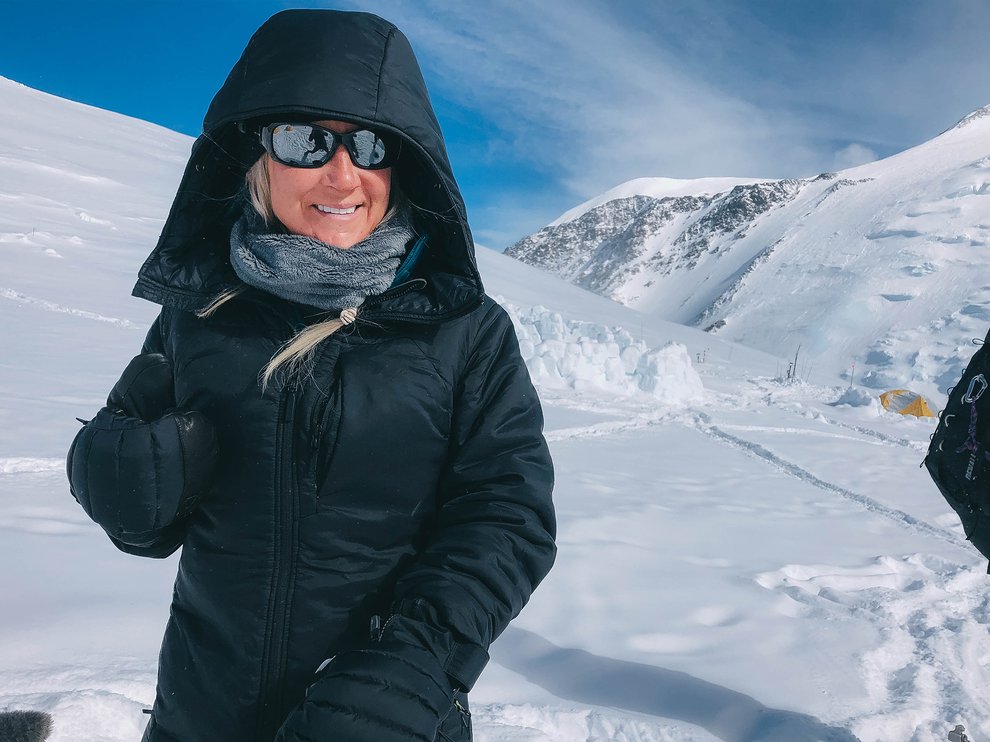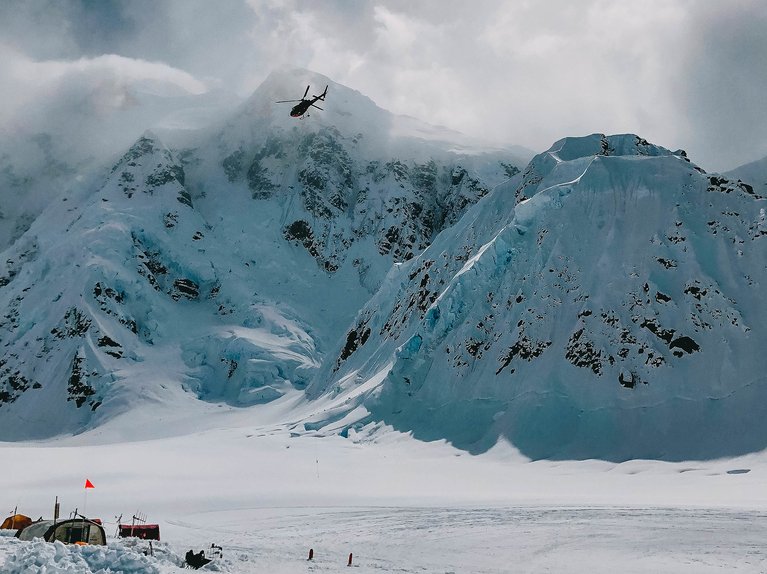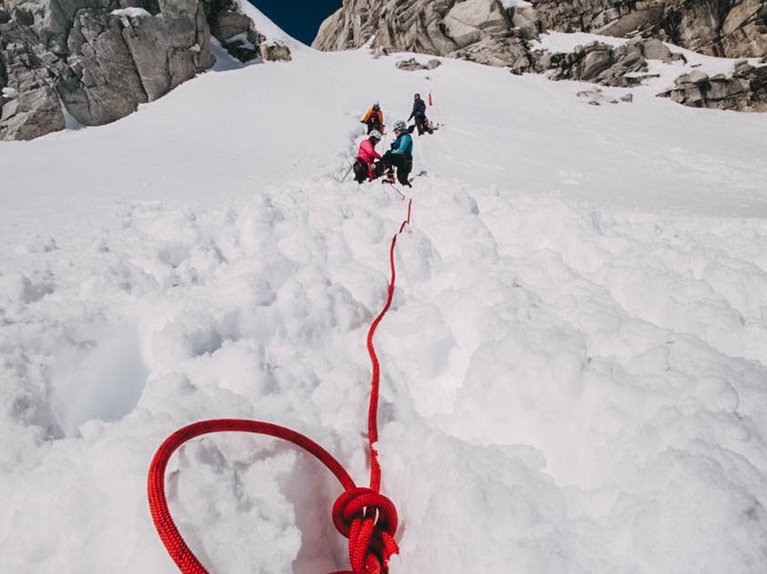Para-Snowboarding Athlete Kirstie Ennis Takes on the Highest Peak in North America
At 27 years old, Kirstie Ennis has been through more than most people have in a lifetime.
In 2012, while serving in the US Marine Corps, she was involved in a helicopter crash that left her with a traumatic brain injury, severe facial trauma, a left leg above-the-knee amputation, and damage to her cervical spine and upper arms.

After a long road of recovery, her goal is to be the first combat veteran amputee to reach the Seven Summits (the highest point on each of the seven continents) as well as the North and South Pole. On this journey, she is dedicating each summit to a nonprofit that is meaningful to her. So far, she has risen up to the challenge by completing Kilimanjaro (19,341’), the highest point in Africa, and Carstensz (16,024’), the highest point in Indonesia that’s also known as the most technical and volatile of the Seven Summits.
With a long list of Burton gear along for the journey, she most recently set her sight on Denali (20,310’). After a total of 30 days on the Alaskan mountain—the entire month of June—through wind, snow, and freezing temperatures, her team was unable to summit. Kirstie’s determined to try again in 2020, but she's not taking any pauses. When we caught up with her, she had her sights on ascending Europe's highest point: Mt. Elbrus (18,510’, Russia).
We caught up with Kirstie in between expeditions to hear about her awe-inspiring mission. Without a doubt, her perspective, perseverance, and strength will stick with you long after reading.
"I am ecstatic that we were on an all-women rope team. Only 7% of the people that attempt Denali are women."


Denali is a massive undertaking, and you didn’t go at it alone. Tell us about your expedition team.
My rope team consisted of three other badass women. I am ecstatic that we were on an all-women rope team. Only 7% of the people that attempt Denali are women. Kirsten Kremer (lead guide) is a crusher of all things outdoors. Beth Cleary (guide) is a lady I met who actually put me through mountaineering training in preparation for this climb. She has worked with amputees in the past. Katelyn Sheehan (together we have also climbed Cotopaxi and Iliniza Norte, both high altitude Ecuadorian volcanos) is an Air Force veteran who I was lucky enough to meet by chance, and am now even luckier to call a friend.
What did you do to prepare for Denali?
I spent two years training for Denali. Part of that involved summiting mountains on three other continents. We went through winter mountaineering courses and did everything possible to test the prosthetic systems that I rely so heavily on. The physical aspect of mountaineering isn’t the hardest, you can convince yourself to keep pushing—however, the mental game of mountaineering is quite difficult. It is just as important to train your mind as it is to train your body for these types of endeavors.
Kirstie’s Expedition Necessities
- Burton Evergreen Synthetic Down Hooded Jacket: Down comes in so clutch at high altitude especially while moving. As we generated heat moving up, I would often be wearing just a t-shirt and this jacket. I love the fit, too. A lot of hooded down jackets on the market are short and wide. This one fits long enough to stay under my harness without blocking access to the tools I need.
- Women's Burton [ak] Turbine Fleece Quarter Zip Fleece: This is a must-have and was my go-to above 14,000-feet on Denali. So warm!
- Burton Cora Neck Warmer: At high altitude, this kept my face extremely warm and fit well under my helmet. Nice and soft, which my face appreciated due to the strength of the late spring sun and high winds.
- Burton [ak] Oven Mitt: On the descent and on days with poor weather, these mittens kept my hands safe and comfortable. The rest of my team suffered with their hands and toes, however, I never once had an issue.
- Burton Powerstretch® Glove Liner: I wore these liners nearly every day. The close fit allows for warmth, but more importantly dexterity. Being able to safely handle ropes, gear, and climbing devices is so important.
- Family Tree Anti-Social Splitboard: This is the way to go when it comes to climbing and is even more fun on the ride down. Considering my body works differently now, I need lightweight and I got it with this board. When I walk, I suffer while post-holing in deep snow; this splitboard allows me to move efficiently without exhausting myself.

What surprised you most about your Denali experience? I was mostly surprised by the weather and by what I struggled with. The weather is beyond impossible to plan for. One would think with it being a glacial climb, that the conditions would be cold. However, due to cloud cover and thin air, the sun scorched us many days. Often times I ended up in a t-shirt moving higher. I have also trained for years on a variety of terrain, only to struggle with traveling through soft snow. It’s never the technical or vertical, but always the soft terrain that challenges me most. Quite frankly, I underestimated just how much my prosthetic side would sink in and slow me down.
"Rising up to new challenges makes me feel alive."
You plan on hiking each of the Seven Summits. Can you tell us more about that goal, your progress, and who or what inspired you to do this? I intend to climb each of the Seven Summits mainly to inspire people to use more of their potential. All too often we hear, “I can’t.” However, we can. Regardless of the circumstances, we control our potential—we just have to figure out the means to say “I can.” I am dedicating each expedition to a non-profit that has either helped family, friends, or myself, or is a non-profit that has a mission I can genuinely stand behind. I also simply enjoy being able to put myself through the ringer and achieve the unthinkable, even though at times it seems to be the hardest thing I have ever done. Rising up to new challenges makes me feel alive.
Describe your hardest day on the mountain and how you persevered. Surprisingly, my hardest day was on the descent from high camp at 17,000-feet to 14,000-feet. It wasn’t necessarily because the terrain was the worst or because of endurance, it was more so because of the pressure I felt. I was out in front leading the team down a knife edge with low visibility and high winds—one wrong move would have resulted in thousands of feet of falling. These are the moments when I recognize how important it is to have a strong and trustworthy team. These ladies were dedicated, to say the least—they knew the risks and they faced them head-on. I am forever grateful.

Will you do anything differently as you prepare for more of the world’s highest peaks? I honestly wouldn’t change much about my preparation or training regimen. I can’t control the conditions or the weather. This year was simply a rough year for all climbers on Denali. All I can do is take what I have learned from this experience and apply it to the other mountains.
What keeps you going? I stay motivated by recognizing that there are other generations, older and younger, of people watching me. The things that I do now could set a precedent for how people handle adversity and how they overcome what they struggle with. Yes, I am “disabled,” but that doesn’t mean I can’t redefine what it means to be “disabled.” I really hope to set the stage for more men, women, children, and amputees to be active outside.
For Kirstie’s harrowing firsthand account of her Denali expedition, check out her blog. ∆